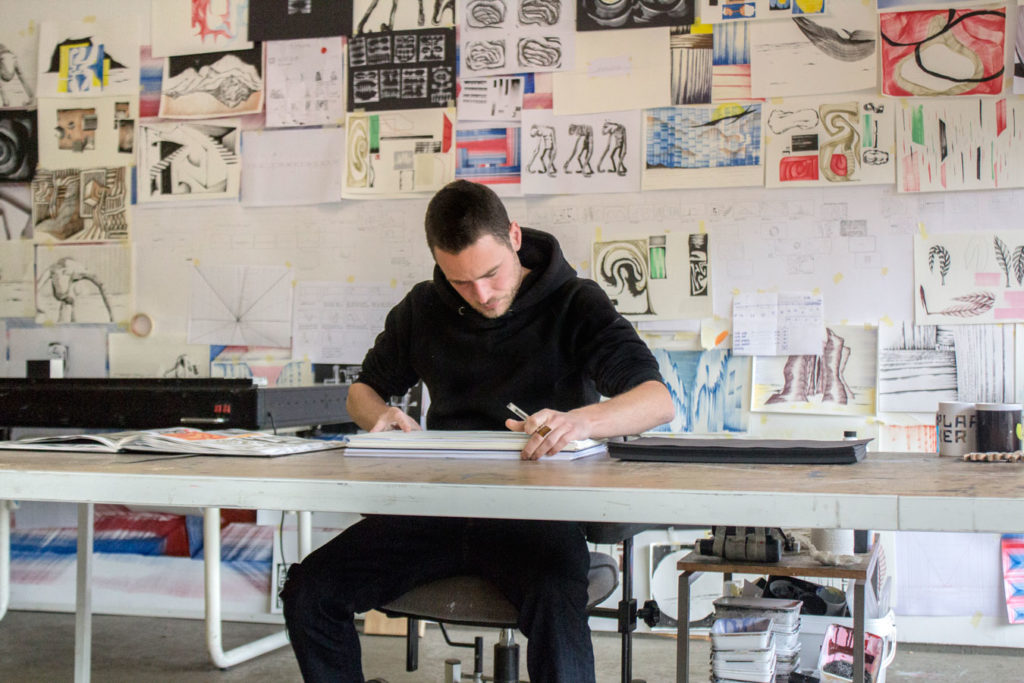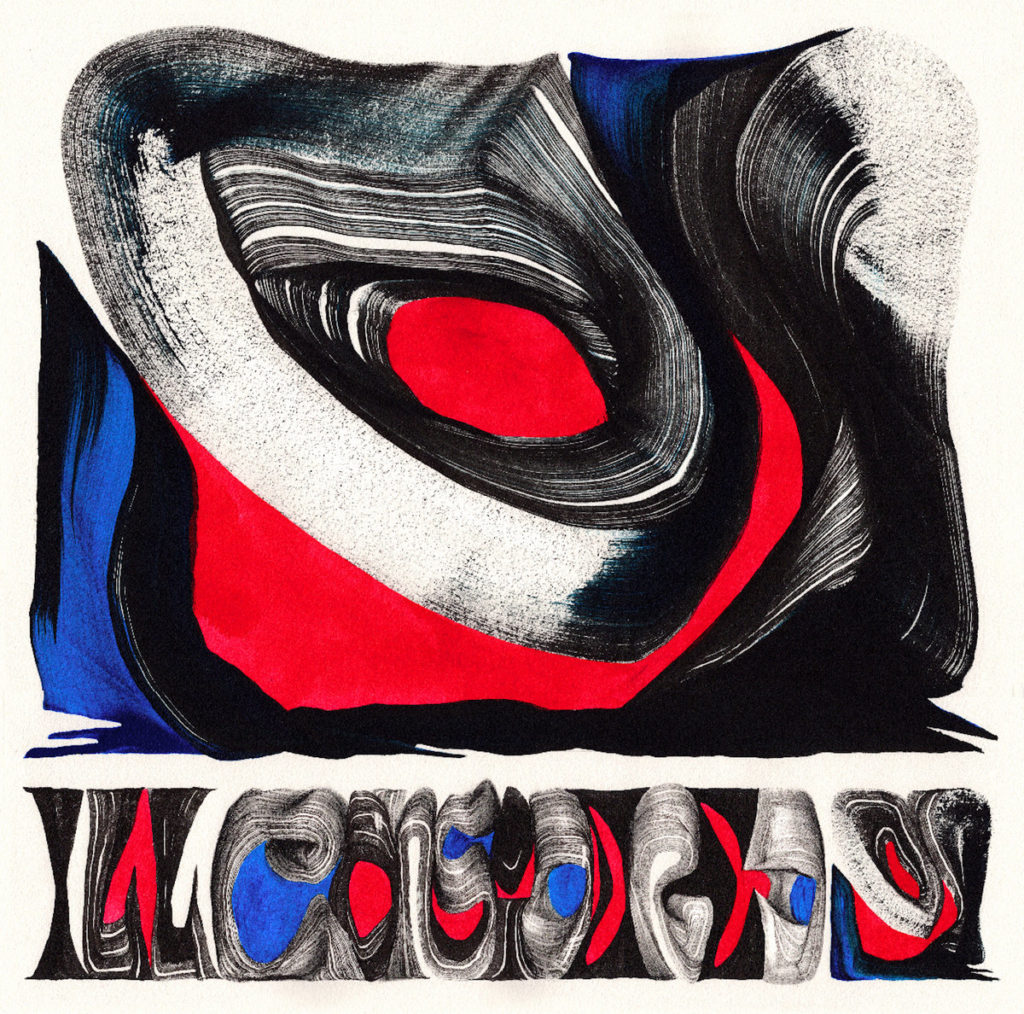CF: Tell us a bit about yourself. How and when did you decide to start a career in art and design?
I’ve never really felt that there was a clear beginning for my creative path, it’s always been with me. I started drawing very early on as a little child and it was soon inevitable that I would end up working with it. Also in a professional sense. Long before I went to art school, during high school, I made posters for the local youth centre and sold mixtapes on the schoolyard with my brother, for which we drew album covers together.
I had been ‘waiting’ for a project like Ill Considered: a music project with a strong energy, not too much talking
CF: At what point did you start specialising in Typography and Calligraphy?
In high school I started collecting flyers, mostly hip-hop related. I tried to copy these by drawing, including the letters. I looked around a lot, saw a lot of letters in the skate and graffiti culture. Before I started with calligraphy I often drew letters, with pencil or fineliner. The moment I realised that with a broad pen or brush you could write the letter including its fill-in all at once was a special experience. That must have been a year or two before I went to art school. During art school it was mainly the typographical interest that was triggered, we didn’t have specific lessons in calligraphy. I did that myself, in addition to the lessons.

CF: What or who were some of your early influences and what are you inspired by now?
I think the inspiration used to come mainly directly from things I saw. Visual things. For example, a poster from a designer, a painting or a drawing. Or record sleeves from the seventies for example. At the moment it’s more a certain idea or feeling that drives me in a certain direction. I’m fascinated by the brushstroke, I find it surprising how many different outcomes are possible. One brushstroke already tells me what the next one could be. At times in the studio it’s not more difficult than that: Just sit down in front of a white sheet and ‘listen’ to what the brush is asking for.

CF: How did your collaboration with Ill Considered come about?
I remember seeing a white label on youtube, with a handwritten title. Just with a pen. That was their first album, suddenly on youtube, with only a hundred views. I was immediately interested. Then I found Wildflower’s first album, and I bought both directly on vinyl. I collect vinyl records. I was so blown away by how great the music was that I wrote a note with my order, including my appreciation for the music. I got a message back and that’s how our contact started.
I didn’t make the first album cover with the idea that it was going to be a huge series, but I am used to making series in my art practice, so it wasn’t a problem when suddenly 4 albums a year were released. What also has a lot to do with it is that I had been ‘waiting’ for a project like Ill Considered: a music project with a strong energy, not too much talking. In terms of working method, this fitted exactly to a need I had with art making. The first album came from one evening in the music studio, cut to about 40 minutes and mastered and pressed right away. Done. No doubt is possible simply because it is already finished before you know it. In a certain way this correlates with calligraphy: you need years of practice, after that one could produce something solid in the blink of an eye.

CF: What can you tell us about The Stroke, your latest collaboration with the band?
It was a very nice and special project to work on. Also very intense, because it was such a huge amount of work. A kind of drawing-marathon. I’ve been working on it for 2 years in total, from the first ideas and sketches to the completion and the exhibition that opened last week. During the making of the album covers in 2017, the first year of our collaboration, the idea soon started to develop the collaboration into something larger. The visual language that was created is rich and ready for the next step.
It gradually became clear that making a film really had to be done frame by frame. By means of tests I did in the studio it turned out that this gave the strongest connection to the rhythm and the most beautiful result. At the same time it became clear that it would mean a lot of work. Four months of drawing-time turned out to be a bad estimation, it turned out to be 9 months.
Fortunately, I had soon asked a friend of mine, Hans Schuttenbeld. He came to work in my studio for almost nine months every other week. This way we had some kind of superfocus, where you easily forget all other things because we were busy with only one thing all day from breakfast till night. Hans is, just like me, a big fan of Ill Considered so we were on exactly the same page.
CF: Ill Considered aside, if you could soundtrack your work what would you choose?
For quite some time now I’m into Vladislav Delay’s album Entain. A record that is often playing in my studio. The repetitive nature of the music can be linked in a certain way to my work and working methods.
I’ve never really felt there was a clear beginning for my creative path, it’s always been with me
CF: What’s your favourite thing about living in Utrecht? What would you recommend to someone visiting for 24hrs?
I don’t know if I am a good tour guide because I will recommend people to go out of town because there is so much beautiful nature nearby 🙂 What is really nice about Utrecht is to walk through the city centre, the architecture is great.
CF: Are there any other exciting projects you could tell us about? Any dream projects or new mediums you’d like to work on in the future?
What I’m most looking forward to at the moment is to continue with a certain way of working that I developed last year when I lived in Japan for a short while. It’s a certain repetitive way of working on a roll of paper, where you can’t see the complete work while making it, but only a fragment. Now that the animation project is coming to an end, there will be some time and space to focus on that. In the coming year, together with Jonas Wijtenburg and Frank Koolen, we’re going to make a large installation in which this new way of painting will find a place.



